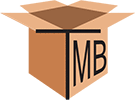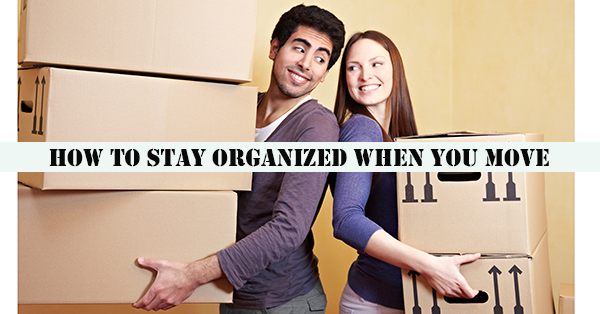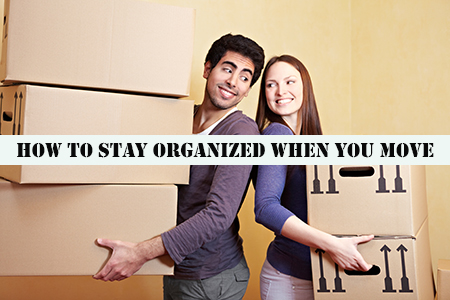 Saying that proper organization is the key to a successful house move is quite an understatement.
Saying that proper organization is the key to a successful house move is quite an understatement.
In reality, getting organized and then staying organized when moving is the key, the lock, the door, and the path that will take you straight to the new home with minimum efforts and zero problems along the way.
Without a doubt, the best way to get organized for a move is to use an exceptional moving checklist – a detailed to-do list that will guide you on your relocation journey from start to finish.
Yes, having a printable moving checklist by your side will improve greatly your move organization. Nevertheless, there are also some other great tricks to stay organized when you move to another home.
Want your move to be a successful move? Here are the top 10 ways to stay organized when moving:
- Organize your move early
- Set up a moving budget
- Make up your mind: movers or DIY?
- Inventory all your possessions
- Declutter your home
- Organize your paperwork
- Have a good packing plan
- Get free packing supplies
- Pack your essentials last
- Label boxes properly
- BONUS: Use a free move organization app
1. Organize your move early
One of the best ways to stay organized when moving is to have enough time to finish all the pre-move tasks in an un-rushed way. It’s important to be able to think things through without having to make any hasty decisions due to lack of sufficient time.
And one excellent way to get time to be your ally is to start the move preparations as soon as you possibly can – that is, immediately after the house move has become only a matter of time.
Once the decision to move house has been made, there isn’t any time to postpone the inevitable. By securing more hours and even days to work on your relocation agenda, you will also keep the stress levels within healthy limits. In case you didn’t know, moving to another home is one of the 3 top stressful events that can happen in your life.
Remember that it’s never too early to start getting ready to move out. In the best-case scenario, you will have at least a month (approx. 4 weeks) to organize your move. What’s more, proper move organization will lead to good time management, which in turn will also enable you to get ready to move out in less time.
2. Set up a moving budget
How to prepare for a move? Make sure you create a moving budget early on in your preparation so that you know the approximate cost of the upcoming move. Being aware of the future moving expenses in advance will get you financially and mentally ready when the times comes for you to pay up those bills.

How much will your move cost?
Sometimes you can find out that you don’t have enough money saved to move out, which in turn may force you to use one of the proven techniques to move out for less money. Also, setting up a moving budget should help you recognize when a moving task requires more money than you have originally allocated for it, thus giving you enough time to respond to that case of overspending and hopefully fix it.
Here’s what to budget for when using the services of a professional moving company:
- Moving company fees: either charged by the hour (local movers) or charged a flat fee (intestate movers);
- Additional insurance: get a Full Value Protection if you’re moving a number of high-value items with you;
- Extra moving services: each additional moving service will cost you extra. Accessorial services include: packing, unpacking, furniture disassembly, temporary storage, custom wooden crating, and so on.
- Extra charges and fees: factor in any additional charges such as flight charge, long carry charge, bulky items charge, extra stops fee, etc.
Get a free moving estimate to learn how much it’ll cost you to hire movers.
Here’s what to budget for when moving by yourself:
- Truck rental cost: the cost of renting a moving truck will depend on the moving truck rental company, the size of the moving vehicle, the current availability of moving trucks, and the season in which you’re moving.
- Fuel: the cost of fuel will be a substantial DIY expense. On average, rental trucks consume up to 12-13 MPG.
- Moving equipment: in most cases, you’ll need to rent or purchase a moving dolly, furniture sliders, moving straps, and moving blankets.
- Packing expenses: moving boxes will be your biggest packing expense, but don’t forget about the cost of bubble wrap and packing paper.
- Unexpected DIY moving costs: unexpected DIY moving expenses can come from anywhere, so include a contingency fund into your moving budget.
What to budget for when moving out
3. Make up your mind: movers or DIY?
As a rule, the best way to organize a move is to know exactly how you’re going to move to the new house or apartment – using the services of a moving company or organizing a self-move. Of course, that decision will be critically important and will set the tone for the next tasks in your moving checklist.
Should you hire movers or should you move by yourself? At times it can be a real dilemma which way to go. The following questions should help you find the best way to prepare for a move:
- How far are you going? When you’re moving only a short distance away (up to 100 miles within the same state), then you can decide to rent a moving truck and transport your items by yourself. When moving long distance though, the DIY risks and dangers become too great, so you’d better hire one of the best interstate moving companies in the country.
- Are you moving specialty items? It’s obvious that if you happen to be moving a specialty item with you: antique furniture, a piano, a pool table, a hot tub, a grandfather clock, etc., then you should definitely hire specialty movers for the job.
- Will your friends help you move? If you know that you can rely on your trustworthy friends to come help you pack up your things and move heavy furniture and all those boxes, then you may be willing to try to move without professional assistance. But if you just know that nobody will come to your aid, then do the sensible thing and hire professional movers.
- Are you moving house for the first time? Move-related experience matters more than you think. So, if you’re a first-time move and have no idea how to prepare for a move, then you’d better leave it all to experienced full-service movers.
4. Inventory all your possessions
Another great way to get organized for a move is to know exactly what it is that you will be moving. Proper moving organization requires you to have a good plan and a fool-proof strategy before you start work on your due tasks. And, as you should know well by now, throwing all of your possessions randomly into random cardboard boxes just won’t yield any good results.

Before you can start packing up your things, you’ll need to know exactly what things you have for packing.
One of your priorities when moving house is to create an inventory of all your household items – just go into each room and then make a list of the things found there.
Then, while creating that inventory sheet, you should keep sorting out and dividing your possessions into 4 major categories: Move, Sell, Donate, and Throw away.
- Move. These are the things you’ll be taking with you regardless of the time you’ll need to pack them and the cost you’ll pay to move them.
- Sell. Why not sell some of the items you leave behind to help out your budget? This is especially true for items you don’t need but are still worth something.
- Donate. Your junk may easily become somebody else’s treasure. Do consider donating some of your possessions to be used by less fortunate people.
- Throw away. Some things will have surely become useless in time, so they’ll only be good for one thing – recycling.
How to inventory your home when moving
Read on to learn why decluttering your home before moving out will only bring benefits for you.
5. Declutter your home
Without a doubt, one of the best ways to get organized for a big move is to get rid of all the clutter in your home before you start packing up your items. Moving experts are unanimous that if you haven’t used an item in over a year, then you don’t really need it, so it’s time to let it go.
In fact, the event of moving to a new home is the perfect opportunity to reduce the number of your belongings and leave only the things that
- you intend to use in the foreseeable future,
- you really like and want to keep,
- have sentimental value for you, and
- are not irreparably broken or worn out.
Creating an inventory of your possessions was the first step to getting organized during a move, now it’s time to finish the decluttering job properly. Save transportation money, packing time, and new-home space by leaving only the items that are worth moving to the new residence.
So, once you’ve set aside the belongings you won’t take with you,
- SELL online or organize a profitable garage sale for the things that still have any commercial value;
- GIVE AWAY to family members and friends who may need any of the items you’re leaving behind;
- DONATE to charitable organizations; or
- RECYCLE the useless stuff nobody will ever need again.
How to get rid of stuff when moving house
6. Organize your paperwork
In most cases, a house move generates a lot of paperwork. So, one of the best strategies for staying organized during a move is to keep all of your moving paperwork in one secure place – preferably a binder that you can have with you at all times.
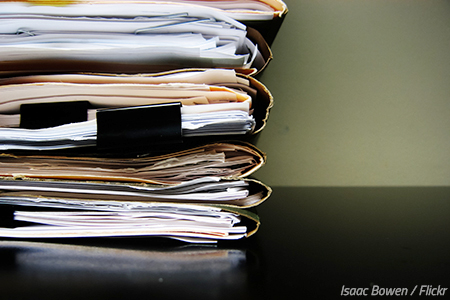
Your move will generate a lot of paperwork. Stay organized by keeping all important documents in one safe place.
Remember that it’s important to keep your moving paperwork safe even after the move is over (in case any disputes arise with your mover). Such documents include
- moving cost estimates,
- order of service,
- bill of lading,
- home inventory sheets,
- moving checklists,
- floor plans,
- list of donations,
- school and medical records,
- financial documents including all types of receipts, and
- any other moving company paperwork imaginable.
Of course, the idea of getting organized when moving house is also about protecting all important documents that are not move-related. If there is enough space in your moving binder, you are strongly advised to also keep there
- personal documents (birth certificates, marriage and death certificates, divorce and separation documents, passports, driving licenses, etc.);
- employment documents (labor contracts, evaluation reports, etc.);
- housing documents (property deeds, rental agreements, mortgage documents, rent receipts, utility bills, etc.);
- legal documents (wills, Power of attorney documents, etc.);
- financial documents (bank statements, payroll slips; debit and credit card receipts, tax receipts, etc.);
- motor vehicle documents (vehicle registration, auto insurance documents, receipts, etc.), and so on.
20 Tips for Moving Long Distance: Moving Checklist
7. Have a good packing plan
Our tips for an organized move come to packing – the most time-consuming and labor-intensive task in your moving agenda. To stay organized during the entire packing process is a challenge in itself, so you’re going to need to adopt and use a good packing strategy that will work great for you.
To organize your move like a professional and to handle successfully the tough task of packing for a move, you’re going to need to familiarize yourself with several key packing strategies:
- Start packing immediately. Don’t waste any precious time thinking about how you need to start packing your items soon. Do not put off packing for a later time, do it now.
- Follow a packing timeline. Initiating the packing job is easier said than done. How do you pack up an entire home? Where do you start packing for a move? Follow a good PACKING TIMELINE to use efficiently every single hour of the time prior to Moving day.
- Know where to start packing. Your own packing checklist will guide you from start to finish, and the start should always be from the areas in your home that are the hardest to pack – the storage areas such as the basement, garage, attic, walk-in closets, and guest rooms.
- Get the right packing supplies. Proper packing materials are must-have for a successful packing experience. Make sure you get enough moving boxes, packing paper, bubble wrap, and packing tape before you commence the job of packing up your things for a move. And don’t forget that you can save good money by getting free moving boxes.
The best packing tips when packing for a move
8. Get free packing supplies
Knowing how to organize a move is crucial for the success of the entire house moving operation. But before you can start packing up your things as part of your organization stage, you’re going to have to get the proper packing materials to protect your belongings while the latter are on the road to the new address.
Moving house is an expensive business so you should welcome any tips or tricks for bringing down the moving cost. When looking for good ways to stay organized when you move, securing free packing supplies will definitely help you keep the packing expenses at a minimum. For your information, the average cost of the packing materials needed to pack up a 3-bedroom home is approximately $250.
Organize your move in such a way that you end up finding cardboard boxes, bubble wrap, and packing paper without paying for them. That’s right – getting your hands on free packing materials is perfectly feasible… as long as you’ve got enough time to spare and the will to go hunting for free packing supplies.
Follow the link below to learn more about how to find free packing materials in your town or city. After all, why should you pay for something when you can get it for free, right?
Where to find free packing materials
9. Pack your essentials last
Staying organized when moving will always be challenging, even if you do happen to be following a great packing and moving checklist. It’s never an easy thing to put all of your belongings into cardboard boxes and move them to a new home that may be hundreds or thousands of miles away.
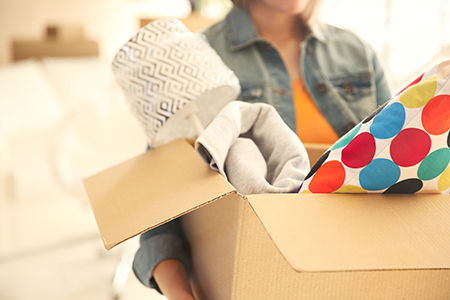
Pack your essential items last and keep them with you at all times.
And while it’s vital that you start packing for your move as early as possible, you will still need all of your essential items right up until the day of the move.
Be mindful that essentials such as kitchen utensils, bed linen, bathroom items, prescription medications, and other important things should be packed last of all simply because you will need them until the very last moment.
Stay organized while moving by packing one or several open-first boxes full of all the essentials that will help you survive the first night and day at the new place until the rest of your household items get delivered. These essentials boxes must stay with you during the actual move and should be the last things you load into your own vehicle.
What to pack first when moving
10. Label boxes properly
Labeling your boxes correctly is the perfect example of how to get organized for a move. With so many cardboard boxes that look rather similar or even identical, it’s fairly easy to lose track of what’s inside each one unless you clearly write the content on each container.
One rookie mistake that some people tend to make is to think they will be able to remember what they pack in each cardboard box during the packing task. What you should remember, though, is that the home moving process puts people under a lot of stress, and the more stress there is, the easier it is to forget things even if someone is blessed with an infallible memory.
How to stay organized while moving? Take a black marker and write down the contents, the destination room, and any special handling instructions /FRAGILE, HANDLE WITH CARE/ on the top and on one of the box sides. Labeling each box will take a minute or so of your time but that is nothing compared to the time it will save you at the time of unpacking the freshly-delivered boxes in the new home.
When labeling your boxes as part of your effort to stay organized when you move, you can select between two proven box labeling methods: color codes or numbers.
Using the color-coded system (different colors for different rooms) is simple yet effective enough to be the preferred labeling system for most people. Nevertheless, using numbers to label each box can save you time because you won’t have to write the contents and destination room on each container. Thus said, you will still need to create a master inventory list and make sure you don’t lose it during the move.
How to label moving boxes like a pro
Bonus advice: Use a free move organization app
There’s no denying that technology has made our lives easier and more convenient. Is there a reason why we shouldn’t use high-tech strategic tricks to get and stay organized during a move as well? No, there isn’t.

Let modern technology help you stay organized when moving to a new home.
There are a number of excellent moving apps out there that will help you introduce order and structure into your own house move. From letting you find a reputable moving company to helping you inventory your entire home and providing you with a detailed moving checklist, the best moving apps will quickly give you the assistance and guidance you need to finish your household move with flying colors.
Take a look at the top 5 move organization apps that are 100% free to download and use on your mobile device. Technology is meant to help us along the way, even when that way leads to a new home.
